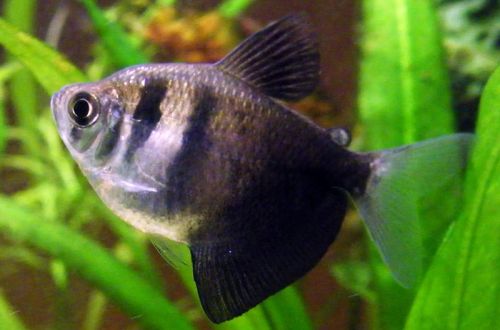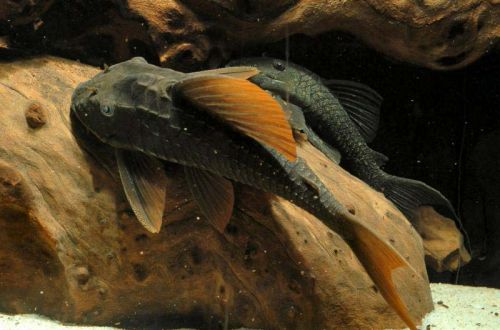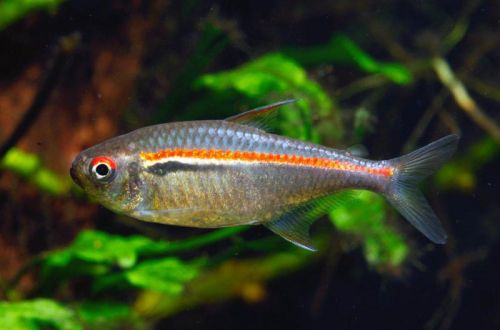
Thornsia
Ternetia, Black Tetra or Black Widow, scientific name Gymnocorymbus ternetzi, belongs to the Characidae family. An excellent fish for a beginner – hardy, not demanding and easy to breed in home aquariums. In addition, it is highly active and quite interesting in appearance.

This species has long been known among aquarists, several new morphological forms differing in color and fins have been bred, such as the White Tetra and the Longfin Tetra.
Contents
Habitat
The Black Tetra was described by the Belgian zoologist Albert Boulenger in 1895. Found in South America in Paraguay and Brazil in the Guapore River basin, where it lives in the upper layers of the water, feeding on small worms, crustaceans, and insects. Tetra prefers small shaded forest rivers or streams with a weak current.
Description
The fish has a high laterally compressed body, small size, in aquariums it rarely exceeds a length of 5.5 cm. It is characterized by two distinct vertical stripes located in the front of the body, and a large dorsal and anal fins. The similar size and shape of the fins look like a woman’s skirt, which, coupled with the dark color of the fish, gave her the name Black Widow. With age, the color of the fish changes, it becomes lighter.
Food
Despite the fact that in the wild the Black Tetra has a predominantly meat diet, in home aquariums it will also accept dry industrial food (flakes, granules) with pleasure. For Tetrs, there is a large selection of special feeds containing all the necessary elements, including freeze-dried meat products. If desired, you can diversify the diet with bloodworms or large daphnia.
Maintenance and care
The only important requirement is clean water. A high-performance filter and regular water changes of 25%-50% every two weeks do an excellent job of this task. Of the equipment, a heater, an aerator and a filter are sufficient, where peat is used as a filter material. This will provide the desired composition of water without the use of additional chemicals. Since fish prefer subdued light, additional lighting is not necessary if the aquarium is located in a living room with constant bright light.
The design welcomes low plants planted in groups, keep in mind that they must be shade-loving, capable of growing in low light. Soil of dark fine gravel or coarse sand, pieces of wood, intertwined roots, snags are suitable as decor
Social behavior
A very active schooling species, should be kept in a group of at least 8 individuals, with a smaller number they can show aggression towards other species, in a large flock all attention is focused exclusively on each other. They become less active with age. As neighbors, choose fish of a similar size and temperament, in no case plant them with small fish.
Sexual differences
The differences are in the shape and size of the fins. The dorsal fin of the male is sharper, the anal fin is not uniform in height, it is long near the abdomen, and becomes low closer to the tail, in females the “skirt” is symmetrical, in addition, it has a large abdomen.
Breeding / breeding
Spawning is carried out in a separate tank, because the fish are prone to eating their young. A spawning aquarium of 20 liters is enough, the composition of the water should be similar to the main aquarium. From the equipment: filter, heater, aerator and this time lighting fixtures. In the design: groups of low plants and a sandy bottom.
Spawning can begin at any time when the female has a big belly, which means it’s time to transplant the couple into a separate tank, after a while the female releases eggs into the water, and the male fertilizes it, all this happens above the thickets of plants, where the eggs subsequently fall. If the plants are located in several groups, the pair will spawn in several zones at once. At the end of the fish return to the general aquarium.
The spawning aquarium is covered with a towel for a couple of days, during which time fry appear. At this point, it is worth turning on the lighting, otherwise the fry in the twilight or darkness will not be able to find food. Feeding with microfeed, Artemia.
Diseases
In good conditions, the risk of disease is very low, in other conditions they are prone to typical diseases of tropical fish. Read more about symptoms and treatments in the Aquarium Fish Diseases section.





